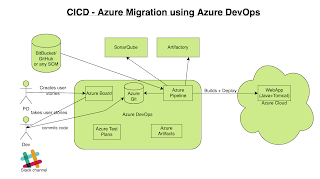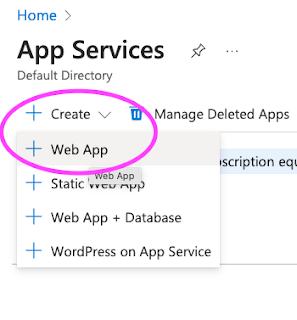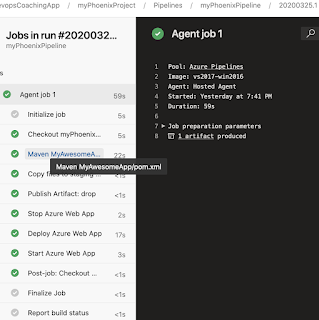
We are going to migrate Java Web App that was setup in BitBucket into Azure Cloud. Since it is a Java WebApp, we need to create a WebApp in Azure Cloud.
WebApp is a Platform as a service capability provided by Azure to deploy any kind of apps including Web apps, APIs, mobile apps.
How are we going to do?
How are we going to do?
1. Create a Webapp in Azure Cloud.
2. Create Azure pipeline in Azure DevOps
3. configure pipeline to check out code from BitBucket and deploy into Azure Cloud on WebApps
4. Run the apps
You need to create WebApp in Azure Cloud. WebApp is an App service (Platform as a Service) provided by Azure Cloud to migrate any web applications.
Once you sign in to Azure Portal, you need to create an app service which is a WebApp.
Step # 1- Creating a WebApp in Azure Portal
1. Now login to https://portal.azure.com
2. Click on App services
3.Click on + Add or click on Create app service(Web App)
Once you sign in to Azure Portal, you need to create an app service which is a WebApp.
Step # 1- Creating a WebApp in Azure Portal
1. Now login to https://portal.azure.com
2. Click on App services
3.Click on + Add or click on Create app service(Web App)

Click on Web App. Choose your Azure subscription, usually Pay as you Go or Free trial subscription
Create a new resource group(for first time if you are creating an appservice, otherwise you can use existing group)
Java Web Server stack --> Tomcat 10.0
Operating System as Linux
Region as Central US or where ever you are based at
Enter LinuxPlan name
Choose SKU and size as given below:
Choose DEV/Test and use 1 GB or 1.75 GB memory
Operating System as Linux
Region as Central US or where ever you are based at
Enter LinuxPlan name
Choose SKU and size as given below:
Choose DEV/Test and use 1 GB or 1.75 GB memory
Now click on Apply & Create
This will take bit time to create the app service.
Once WebApp is created, go resources, click on WebApp name and click on the URL.
You should see the app service home page some thing like below:
Since our WebApp is up and running, now we can start creating pipelines to migrate to Azure cloud.
2. Creating pipelines in Azure Devops
1. Now go to your visual studio project page --> https://dev.azure.com/
Select the Project dashboard you already created.
Click on Pipelines, Builds.
2. Click on New pipeline and click on use the classic editor to create a pipeline without YAML
3. Select source repository as BitBucket cloud and click use user name and password to continue
4. Enter bitbucket user name and password and click on authorize.
Choose your repo by click on ... dots. click continue
5. Since our application is Java stack, type Java and Choose Azure WebApp for Java
6. Modify maven goal as clean install and also choose pom.xml by clicking on three dots ...choose pom.xml
7. Leave the value as it is for Copy Files to staging folder
8. Leave the value as it is for Publish Artifact: Drop
9. Click on Stop Azure WebApp step, Enter Azure WebApp details - where you would like to deploy your app in Azure. Select Free trial subscription from the drop down. Click on Authorize button.
Make sure you disable popup blocker.
10. Do the same in Deploy Azure WebApp & Start Azure WebApp steps.
Enable Webhooks in Pipeline
11. Click on Triggers and then enable check box for Continuous Integration
12. Now click on Save and Queue
13. If your configurations are correct, you should be able to see the build success and able to access in the Azure. Click on Pipelines and pipeline name
Now you will see that Azure DevOps would have started build.
14. Make sure build is success, it should have all green like below.

After successful build, you can check the output by accessing the URL of WebApp:
You can watch the above steps in action in YouTube video:
Clean-up Resources:
After successfully finishing the labs, make sure to delete all the resources created in Azure portal to avoid charges from Microsoft.
Select the resource group in Azure portal, delete the resource group. This will ensure that all the resources will be deleted under the resource group.























No comments:
Post a Comment